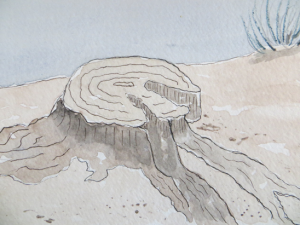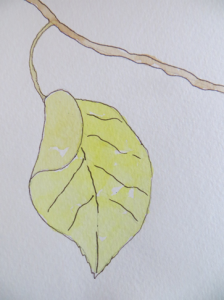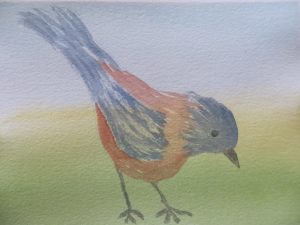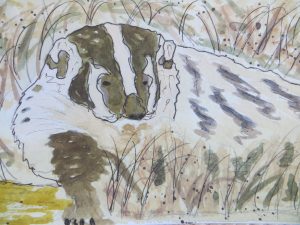“The course of organic evolution has been molded and is
being molded by environmental circumstance.”
– Joseph Grinnell
Geography and Evolution, 1924
It hadn’t occurred to me to inventory trees on the property when we moved to our home outside Santa Fe, New Mexico. It was Summer 2002, and while my husband and I unpacked and settled in, bark beetles killed eighty-eight of our piñon trees: the old and grand, the young and frail. I counted the dead to confirm what I owed the nice man with the wicked chainsaw who removed the corpses. Our neighborhood association board said not to leave the trees for the woodpeckers and other cavity-nesting birds. Fire hazard. We were not to chop them into firewood, unless we covered them in plastic tarps and sunbaked out any remaining larva. No keeping them to chip into mulch, no using them for erosion control. Once the eighty-eight trees were gone, leaving behind ugly stumps and trails of sawdust and rusty-brown pine needles, I counted the survivors. A combination of one hundred sixty piñons and junipers remained. This meant that before the beetle attack, and because of the rainy 1970s, there were two hundred and fifty trees here, too many for one and a half acres of high-mountain desert. I was still heartbroken.

After the beetles, getting used to life in drought conditions was like caring for an aging relative: unexpected events and behaviors were the norm. I once bent down to water a flower pot on the ground and an eight-inch-long lizard I could not identify ran toward me to drink from the hose. I let it. Perched on tree branches only a few inches from my shoulders, mountain chickadees waited as I re-supplied their cylinder feeder with sunflower seeds. My presence also did not spook several robins as they sat on our Bonanza-style wooden fence while I scoured and refilled their bird bath, often their only water source nearby.
As the drought continued, I noticed other opportunistic survivors. Garter snakes surfaced during cloudbursts when what used to be traditional summer monsoons did occasionally still arrive. The snakes curled and twisted their bodies in the rain, just beyond the openings of their dens—former pocket gopher tunnels, abandoned due to drought, disease, or successful predation. We also noticed holes in the black tubes of our drip irrigation system. I suspected the pack rats because they had already decimated the spongey soaker hoses under our remaining piñons by gnawing completely through the rubber. These new holes were the right size to insert goof plugs, but as fast as we repaired them, new openings appeared. I finally spotted the culprit in the act, a male ladder-backed woodpecker drilling for fresh water.
Some plant survivors were also winning. By Summer 2017 our septic system’s leach field achieved nearly fifty percent coverage by native vegetation. When we moved in, the space was overrun by non-native weeds. After a dozen seasons of plucking out the invaders—by hand, with extra care to leave no roots—the thirty-foot by forty-foot space now boasts yellow rabbit brush, golden crownbeard, purple asters, even sunflowers, all gaining ground each season.

As we prepare to greet fire season 2018, area snowpack is twenty-six percent of what it should be, according to the National Weather Service. The Drought Monitor Map, produced by the National Integrated Drought Information System, shows that over ninety-seven percent of the state is experiencing drought conditions. We are on course for a transition from piñon-juniper woodland to arid grassland. I expect to hear any minute from a neighborhood association board member that we are “required” to cut down our three dead aspen trees next to the house. Not doing it. A resident pair of ladder-backed woodpeckers drilled their nest cavity in the largest of these. They have already fledged at least two chicks in prior seasons, and a male has roosted there all winter. About a foot higher, on the other side of that same aspen, is another cavity, and I suspect its inhabitants are a pair of white-breasted nuthatches. There is evidence of new cavity drilling in both other aspens. The trees stay. We also assist the western bluebird population. Audubon’s Climate Report projects a sixty-three percent loss of their winter range by 2080 so we mount our third bluebird nest box. “Don’t be discouraged if birds don’t begin nesting in them immediately,” is the advice from Cornell’s Lab of Ornithology. A solitary female takes possession of the new box within eight hours. I long to install nest boxes by the dozen.

Particularly during drought conditions, it’s not my place to mediate what consumes what. When a red racer snake climbs a surviving piñon, and drapes itself around the trunk like a pale pink rope to swallow the ash-throated flycatcher chicks in an old bluebird nest box, I can scream, but not intervene, even though I witnessed the flycatchers’ battle with the bluebirds for possession of that box in the first place. When a scrub jay steals the house finch eggs, I can only watch. When a coyote nabs a rabbit that I’ve been watching since it was palm-sized, it’s not my business. But when a contractor for the water company deliberately plugs the opening of a badger sett—probably without even knowing what it is—I do remove those heavy rocks.

A female American badger dug that sett under one of those ugly piñon stumps that used to make me wistful. Sadly, this sett straddles our property line and an adjacent utility corridor. There were no issues a summer ago when the badger and two pups used that sett for about a week before moving on to another burrow in her network that likely covers two thousand acres. When the county announces plans to install a new water main in that corridor, I mark the sett with three red flags. One of the contractor’s heavy-equipment vehicles runs over the sett and crushes the flags but that piñon stump I cried over is a hero. Its solid root system provides stability, and a canopy that preserves the burrow for the badgers.
As the drought continues, we welcome all these creatures. Every coyote, hawkmoth, bobcat, and migrating bird that finds sustenance here can stay with us for as long as they like.